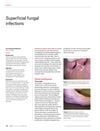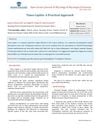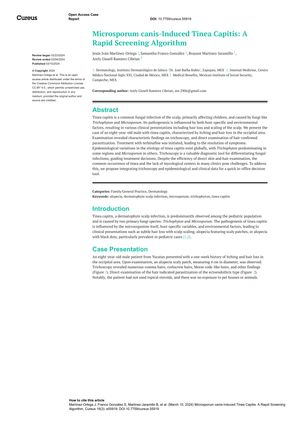TLDR A rapid screening method using trichoscopy and clinical data can improve diagnosis and treatment of tinea capitis.
Tinea capitis, a fungal scalp infection mainly affecting children, can be caused by fungi such as Trichophyton and Microsporum, leading to symptoms like hair loss and scalp scaling. This study discusses an eight-year-old male with tinea capitis caused by Microsporum canis, diagnosed through trichoscopy and direct hair examination. Treatment with terbinafine resolved the symptoms. The study highlights the global epidemiological variations in tinea capitis etiology and proposes a rapid screening algorithm combining trichoscopy with clinical and epidemiological data to improve in-office diagnosis and treatment decisions.
 54 citations
,
October 2019 in “Australian Journal of General Practice”
54 citations
,
October 2019 in “Australian Journal of General Practice” Accurate diagnosis and treatment are crucial for managing superficial fungal infections, with terbinafine being the best oral treatment for nail infections.
 143 citations
,
October 2008 in “Journal of The American Academy of Dermatology”
143 citations
,
October 2008 in “Journal of The American Academy of Dermatology” Comma hairs are a specific sign of tinea capitis when viewed with videodermatoscopy.
 January 2019 in “Open access journal of mycology & mycological sciences”
January 2019 in “Open access journal of mycology & mycological sciences” The article concludes that proper antifungal treatment is essential for treating scalp fungal infections in children, and trichoscopy is useful for diagnosis and monitoring.
102 citations
,
January 2020 in “Recent Patents on Inflammation & Allergy Drug Discovery” Tinea capitis in young children requires oral antifungal treatment for effective management.
 January 2025 in “Journal of Clinical Medicine”
January 2025 in “Journal of Clinical Medicine” Unsanitary barber practices can spread scalp infections, treatable with oral antifungals.
1 citations
,
May 2017 in “InTech eBooks” The chapter explains common scalp conditions, including infections, infestations, and tumors.
 January 2022 in “International Journal of Research Publications”
January 2022 in “International Journal of Research Publications” Griseofulvin effectively treats tinea capitis caused by Microsporum canis.





